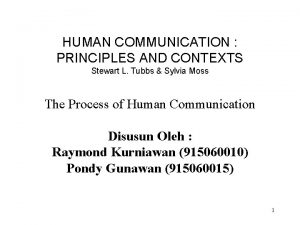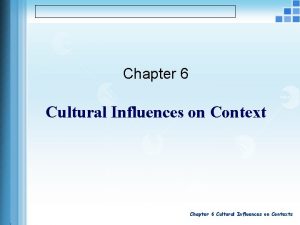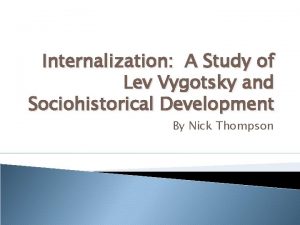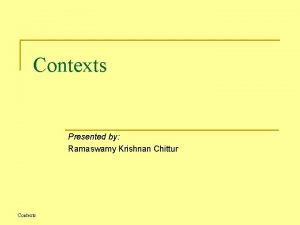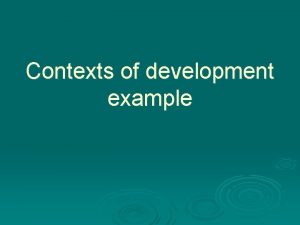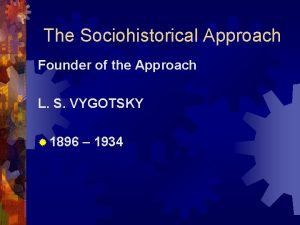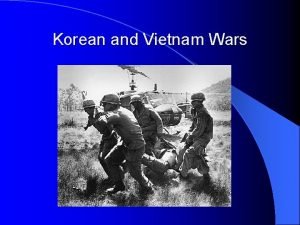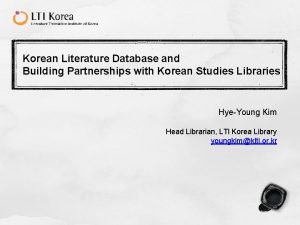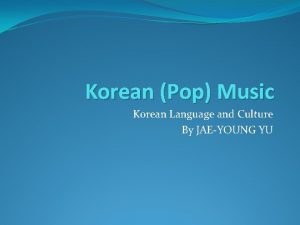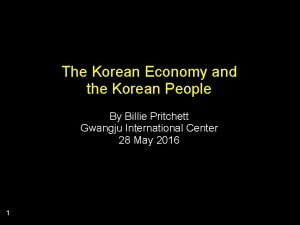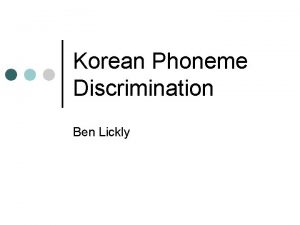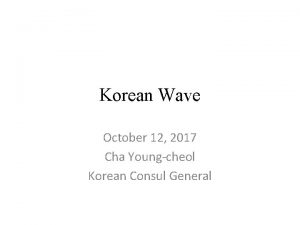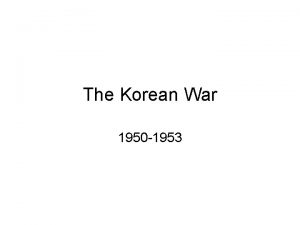Korean women in the sociohistorical and cultural contexts









![Theory of gender and power (Connell, 1987) Structure the constraints on social practice[or agency] Theory of gender and power (Connell, 1987) Structure the constraints on social practice[or agency]](https://slidetodoc.com/presentation_image_h2/6ed2165bdb2697e1408267399b752e86/image-10.jpg)














- Slides: 24

Korean women in the sociohistorical and cultural contexts: Myths of branding ‘women resources development’ Sunghoe Lee (Ph. D. ) Yonsei University amy 44 cam@gmail. com

Sexist Korean labour market Korean women’s low labour force participation rate (age 15 -64): 49. 9%(1990) -> 54. 9%(2011) The largest gender wage gap among OECD countries for 16 years (39. 8% in 2010). Women hold only 1. 5% of the seats on the boards of the top 10 largest conglomerates including Samsung, Hyundai, LG, SK and etc.

Sexist Korean labour market The lowest employment rate of highlyeducated women among OECD countries 62. 1% of female university graduates in 2010 vs. OECD average 82. 6% (92. 2% of male graduates in 2010 vs. OECD average 91. 9%) Korean women’s drastic increase in their progression rate to higher education: 2. 9%(1970) 6. 4%(1980) 32. 4%(1990) 80. 5%(2010)

The comparative employment rate of highlyeducated Korean men/women in 1985 and 2007 Men (1985) Men (2007) Women (1985) Women (2007)

Korean government’s responses Women Resources Development(2006 -) by Ministry of Gender Equality & Family Major target(2011 -2015): Korean women’s labour force participation rate up to 55% Highly-educated women’s labour force participation rate up to 70. 3% In 2008, establishment of the law to promote economic activities of women with disrupted careers (Lee, K. S. , 2012)

The causes and measures of the continuous phenomenon of Korean women’s career interruption (Ministry of Gender Equality & Family, 2013) Causes Measures Assigned Departments Burden of child rearing and housekeeping Support of childcare and after-school Courses Ministry of Health & Welfare, Ministry of Education, Science and Technology Difficult to get a good job that young women want Customized job training for the women who graduated from the universities and career development Ministry of Gender Equality & Family, Ministry of Employment and Labor Difficult to reenter the labor market after the career interruption Establishment of the overall employment support system for the women who have experienced career Interruption Ministry of Gender Equality & Family, Ministry of Employment and Labor Gender-sensitive personnel Administration Ministry of Employment and Labor, Ministry of Gender Equality & Family Support for job and home coexistence Ministry of Health & Welfare, Ministry of Employment and Labor, Ministry of Gender Equality & Family The women-friendly working environment Ministry of Gender Equality & Famliy, Ministry of Employment and Labor Poor working condition and environment for women

The aim of this presentation Why this happened? To explore Korean women’s situation in the socio-historical and cultural contexts drawing on Connell’s (1987) theory of gender and power

Korean history 1910 ~ 1945 Japanese colonial rule 1945 ~ 1948 Transitional military government of the U. S. armed forces 1948 Establishment of the Republic of Korea 1950 ~ 1953 Korean War 1953 ~1960 Anti-communist authoritarian government based on Confucian patriarchy

Korean history 1960 ~ 1987 Military dictatorship: rapid industrialisation, the state’s ‘familialistic’ welfare regime 1987 ~ 1997 Democratisation: enhancement of women’s rights 1997 IMF financial crisis(1997) 1997 ~ present Prevalence of neoliberal ideas
![Theory of gender and power Connell 1987 Structure the constraints on social practiceor agency Theory of gender and power (Connell, 1987) Structure the constraints on social practice[or agency]](https://slidetodoc.com/presentation_image_h2/6ed2165bdb2697e1408267399b752e86/image-10.jpg)
Theory of gender and power (Connell, 1987) Structure the constraints on social practice[or agency] lying in a given form of social organisation such as family, workplace, community, university and nations Agency The transformation of that situation in a particular direction(Connell, 1987: 95)

Theory of gender and power Structure of labour Structure of cathexis: emotion

Structure of power in Korea Heavily masculinised power of the state and business based on academic credentialism

Academic credentialism (‘Hak-beol-ju-ui’) SKY(Seoul National University, Koryeo University, Yonsei University) A format of behaviour for people sharing identical levels of schooling(e. g. graduates of SKY) to form exclusive groups in an attempt to monopolise social positions and resources

Korean academic credentialism (Jung, 2003) Graduates of ‘SKY’ Graduates of Seoul National University 1 st class civil servants in 2001 56. 4% 8. 2% 6. 2% Members of Parliament during 2000 -2004 38. 1% 12. 8% 6. 2% CEOs of listed Korean corporations in 2002 22. 1% 11. 6% 10. 5% Graduates of Koryeo University Yonsei University

Masculinised power of the state Four decades of successive authoritarian military regimes(1945 -87) World Economic Forum’s Gender Gap Index(2012): Korea 108 th/135 countries (Female members of parliament 15. 7% in 2012) (Lee, S. H. , 2012)

Structure of labour in Korea The separation in the labour market between and within gender relations

Labour market segregation within the category of women (KNSO, 2008) Gender wage gap and female/male employment rate by age groups in 2007 Age Gender Wage Gap Female Employment rate Male Employment rate 20 s 14. 1 59. 6 % 60. 5 % 30 s 30. 9 54. 8 % 90. 3 % 40 s 48. 6 54. 8 % 91. 7 % 50 s 56. 1 64. 7 % 84. 6 % 60 s 49. 2 28. 5 % 50. 7 %

Structure of cathexis in Korea Confucian culture as a universal social norm to regulate social relations including gender relationship

Discourse of ‘educational manager mothers’ Strategically invest their familial income for their children’s education, and manage their children’s schedule between mandatory public education and private after-school institutions (Park, 2007, 197 -199). Those who collect information about the private educational market by surfing the internet or through exclusive networks with other (homestaying) mothers

Discourse of ‘educational manager mothers’ The discourse of the educational manager mothers is modeled on university-graduated middleclass full-time housewives

The interplay between the structure of cathexis, power and labour Cathexis Discourse of educational manager mother Power Confucian patriarchy Labour Sexist & ageist labour market

Myths of branding ‘women resources development’ The government’s measures: • Customized job training for the women • Establishment of the overall employment support system • The women-friendly working environment It’s not just about increasing opportunities of vocational education (and of employment) for women! Impact of the structures of gender relationships needs to be considered.

References Connell, R. W. (1987). Gender and power: society, the person and sexual politics. Cambridge: Polity Press. Jung, J. H. (2008). Korean economy and women: The structural change in labour market. Paper presented at The change of Korean women’s lives and future agenda conference, Korean Women’s Development Institute, Seoul. Jung, J. S. (2003). An integrated network between national universities: Innovation in the hierarchy of Korean universities. In Y. S. Kim (Ed. ), Construction of Trans-university Network for Educational Competitiveness (pp. 156 -173). Seoul: Korean Research Fund Korean National Statistics Office (KNSO). (2008). The Indicator of Korean Society in 2008. Seoul: KNSO.

References Lee, K. S. (2012). The current situation and future agenda of women resources development. The HRD Review. November. 166180. Lee, S. H. (2012). Gender, power, and emotion: towards holistic understanding of mature women students in South Korea. Gender and Education. 25(2): 170 -188. Ministry of Gender Equality&Family(2013). Women resources development. http: //english. mogef. go. kr/sub 02_21. jsp (Accessed June, 10, 2013) Park, S. J. (2007). Educational manager mothers: South Korea’s neoliberal transformation. Korea Journal Autumn: 186– 213.
 Shape matching and object recognition using shape contexts
Shape matching and object recognition using shape contexts Human communication principles and contexts
Human communication principles and contexts Template matching
Template matching Professional context
Professional context Writing in academic contexts
Writing in academic contexts Teachers in crisis contexts
Teachers in crisis contexts The sociological perspective stresses that
The sociological perspective stresses that An srs document normally contains
An srs document normally contains Fairness and development global context
Fairness and development global context Intercultural communication in contexts
Intercultural communication in contexts Hát kết hợp bộ gõ cơ thể
Hát kết hợp bộ gõ cơ thể Bổ thể
Bổ thể Tỉ lệ cơ thể trẻ em
Tỉ lệ cơ thể trẻ em Gấu đi như thế nào
Gấu đi như thế nào Thang điểm glasgow
Thang điểm glasgow Chúa yêu trần thế alleluia
Chúa yêu trần thế alleluia Các môn thể thao bắt đầu bằng tiếng bóng
Các môn thể thao bắt đầu bằng tiếng bóng Thế nào là hệ số cao nhất
Thế nào là hệ số cao nhất Các châu lục và đại dương trên thế giới
Các châu lục và đại dương trên thế giới Công của trọng lực
Công của trọng lực Trời xanh đây là của chúng ta thể thơ
Trời xanh đây là của chúng ta thể thơ Mật thư anh em như thể tay chân
Mật thư anh em như thể tay chân Làm thế nào để 102-1=99
Làm thế nào để 102-1=99 Phản ứng thế ankan
Phản ứng thế ankan

